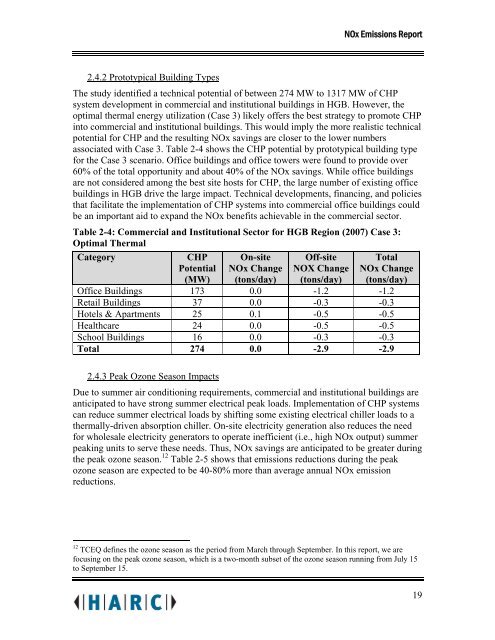NOx Emissions Impacts from Widespread Deployment of CHP in ...
NOx Emissions Impacts from Widespread Deployment of CHP in ...
NOx Emissions Impacts from Widespread Deployment of CHP in ...
You also want an ePaper? Increase the reach of your titles
YUMPU automatically turns print PDFs into web optimized ePapers that Google loves.
<strong>NOx</strong> <strong>Emissions</strong> Report<br />
2.4.2 Prototypical Build<strong>in</strong>g Types<br />
The study identified a technical potential <strong>of</strong> between 274 MW to 1317 MW <strong>of</strong> <strong>CHP</strong><br />
system development <strong>in</strong> commercial and <strong>in</strong>stitutional build<strong>in</strong>gs <strong>in</strong> HGB. However, the<br />
optimal thermal energy utilization (Case 3) likely <strong>of</strong>fers the best strategy to promote <strong>CHP</strong><br />
<strong>in</strong>to commercial and <strong>in</strong>stitutional build<strong>in</strong>gs. This would imply the more realistic technical<br />
potential for <strong>CHP</strong> and the result<strong>in</strong>g <strong>NOx</strong> sav<strong>in</strong>gs are closer to the lower numbers<br />
associated with Case 3. Table 2-4 shows the <strong>CHP</strong> potential by prototypical build<strong>in</strong>g type<br />
for the Case 3 scenario. Office build<strong>in</strong>gs and <strong>of</strong>fice towers were found to provide over<br />
60% <strong>of</strong> the total opportunity and about 40% <strong>of</strong> the <strong>NOx</strong> sav<strong>in</strong>gs. While <strong>of</strong>fice build<strong>in</strong>gs<br />
are not considered among the best site hosts for <strong>CHP</strong>, the large number <strong>of</strong> exist<strong>in</strong>g <strong>of</strong>fice<br />
build<strong>in</strong>gs <strong>in</strong> HGB drive the large impact. Technical developments, f<strong>in</strong>anc<strong>in</strong>g, and policies<br />
that facilitate the implementation <strong>of</strong> <strong>CHP</strong> systems <strong>in</strong>to commercial <strong>of</strong>fice build<strong>in</strong>gs could<br />
be an important aid to expand the <strong>NOx</strong> benefits achievable <strong>in</strong> the commercial sector.<br />
Table 2-4: Commercial and Institutional Sector for HGB Region (2007) Case 3:<br />
Optimal Thermal<br />
Category <strong>CHP</strong><br />
Potential<br />
(MW)<br />
On-site<br />
<strong>NOx</strong> Change<br />
(tons/day)<br />
Off-site<br />
NOX Change<br />
(tons/day)<br />
Total<br />
<strong>NOx</strong> Change<br />
(tons/day)<br />
Office Build<strong>in</strong>gs 173 0.0 -1.2 -1.2<br />
Retail Build<strong>in</strong>gs 37 0.0 -0.3 -0.3<br />
Hotels & Apartments 25 0.1 -0.5 -0.5<br />
Healthcare 24 0.0 -0.5 -0.5<br />
School Build<strong>in</strong>gs 16 0.0 -0.3 -0.3<br />
Total 274 0.0 -2.9 -2.9<br />
2.4.3 Peak Ozone Season <strong>Impacts</strong><br />
Due to summer air condition<strong>in</strong>g requirements, commercial and <strong>in</strong>stitutional build<strong>in</strong>gs are<br />
anticipated to have strong summer electrical peak loads. Implementation <strong>of</strong> <strong>CHP</strong> systems<br />
can reduce summer electrical loads by shift<strong>in</strong>g some exist<strong>in</strong>g electrical chiller loads to a<br />
thermally-driven absorption chiller. On-site electricity generation also reduces the need<br />
for wholesale electricity generators to operate <strong>in</strong>efficient (i.e., high <strong>NOx</strong> output) summer<br />
peak<strong>in</strong>g units to serve these needs. Thus, <strong>NOx</strong> sav<strong>in</strong>gs are anticipated to be greater dur<strong>in</strong>g<br />
the peak ozone season. 12 Table 2-5 shows that emissions reductions dur<strong>in</strong>g the peak<br />
ozone season are expected to be 40-80% more than average annual <strong>NOx</strong> emission<br />
reductions.<br />
12 TCEQ def<strong>in</strong>es the ozone season as the period <strong>from</strong> March through September. In this report, we are<br />
focus<strong>in</strong>g on the peak ozone season, which is a two-month subset <strong>of</strong> the ozone season runn<strong>in</strong>g <strong>from</strong> July 15<br />
to September 15.<br />
19
















